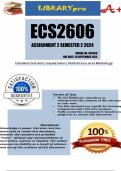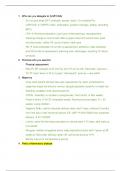ECS2606
ASSIGNMENT 2 SEMESTER 2 2024
UNIQUE NO. 583488
DUE DATE: 20 SEPTEMBER 2024 ECS2606 Assignment 2 Semester 2 2024 Unique number: 583488 Due date: 20 September 2024 Environmental Economics PREVIEW QUESTION 1 In environmental economics, incentive-based policies are designed to encourage individuals and businesses to adopt environmentally friendly practices by aligning economic incentives with environmental goals. Primary types of incentive-based policies 1. Pigovian Taxes Pigovian taxes are levies imposed on activities that generate negative externalities, such as pollution. UNISA@2024 QUESTION 1 In environmental economics, incentive-based policies are designed to encourage individuals and businesses to adopt environmentally friendly practices by aligning economic incentives with environmental goals. Primary types of incentive-based policies 1. Pigovian Taxes Pigovian taxes are levies imposed on activities that generate negative externalities, such as pollution. The tax is intended to internalize the external costs associated with the activity, thereby discouraging practices that harm the environment. For example, a carbon tax is levied on the carbon content of fuels, encouraging companies to reduce greenhouse gas emissions by adopting cleaner technologies. Example: The carbon tax implemented in British Columbia, Canada, has incentivized businesses and individuals to reduce their carbon footprint by making carbon-intensive activities more costly. 2. Subsidies and Grants Subsidies and grants are financial incentives provided to encourage environmentally beneficial practices. These can take various forms, such as direct payments, tax credits, or rebates. They aim to reduce the financial burden of adopting green technologies or practices, making them more attractive. Example: Renewable energy subsidies, such as those for solar panel installations, reduce the cost for consumers and businesses, thereby promoting the use of clean energy sources. 3. Tradable Permits





